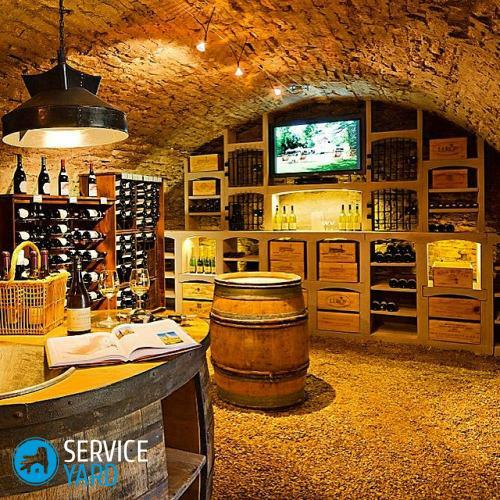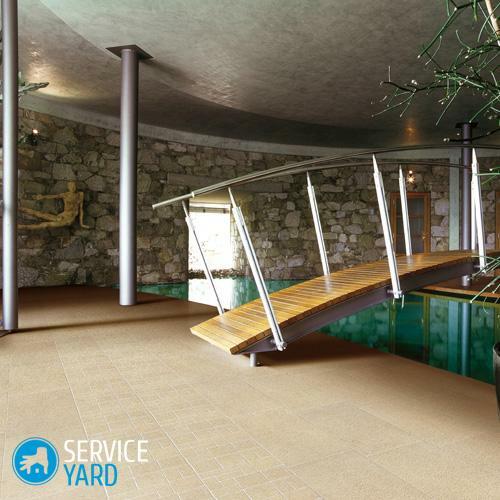
- Where do fungi and mold come from?
- How do I know about the appearance of mold?
- What are the types of fungus in the cellar and how to identify them?
- What is a dangerous fungus?
- How to deal with mold in the cellar and cellar?
- We take out the mold consistently: the work stages
- Precautions for processing the room:
The most favorable place for the appearance of mold is the cellar. The cause of the fungus may be poor ventilation and waterproofing, and as a result - increased humidity and malignant stains on the ceiling and walls. Those who are worried about their health, should remember that if the mold is wound on the walls, then very quickly the fungus will spread to the products contained in the basement and significantly shorten the period of their storage. White mold in the basement, what a dangerous fungus is and what harm to health it can cause, consider in the article.
to the contents ↑Where do fungi and mold come from?
A successful strategy for combating mold is impossible without finding out the reason for its appearance. Mold spores are microscopically small and are able to surround us literally everywhere. When mold spores find a place with optimal conditions for their vital activity, they settle there and begin to develop, forming a mycelium( mycelium), penetrating deep into the materials and forming new spores.
It is the cellar that is the ideal place for reproduction of fungi for the following reasons:
- Absence of circulation - there is almost no air in the cellar or cellar.
- High humidity.
- Condensate formation.
- Poor waterproofing.
- Long-term storage of damaged products.
- Sometimes in the cellar we use boards for shelves infected with a wood fungus.
- Close location to ground water.

How to find out about the appearance of mold?
The first signs of the appearance of the fungus, which should encourage you to find a solution, how to deal with mold in the cellar, are:
- Stale, musty air. The main feature of the fungus lies in its ability to absorb the necessary substances from the environment. Recycling them, mold spores produce carbon dioxide, as well as toxins and ethers, which produce a specific, familiar to all smell of the fungus.
- The appearance of water droplets on the walls, in the ceiling and other structures of the basement. Since the cellar has high humidity, condensation forms on the walls and moisture can not evaporate due to poor waterproofing and ventilation.
Important! To forget about the problem of the fungus forever, you need to establish not only a good ventilation system, but also to eliminate all possible sources of water entering the cellar. If you adjust the humidity in the room, then you will only have to get rid of the mold that has already formed on the walls.
to the contents ↑What are the types of fungus in the cellar and how to identify them?
Fungus is the most ancient organism on the planet. Mold is the national name of the fungus. In our conditions, in the house and office premises, there are the following types of fungus:
- Mold fungus. Usually occurs and appears on concrete, stone, as well as on any other surfaces treated with substandard paint. Mold fungi are spots of black, brown, green or blue. Such a fungus can destroy the entire finish of the house and all the material, so it is quite natural that we must find the most effective means to fight mold in the cellar.
- Blue fungus. It is very dangerous for a wooden house, since it affects the structure of wooden covers and colors the tree in blue. The appearance of blue fungus leads to an increase in wood moisture and penetration of other types of mold. Pine is subject to such changes.
- Rotting fungus damages exclusively wooden surfaces. There are several types of such fungus:
- Bacterial rot. Negatively affects the strength of the tree and colors it gray.
- Brown rot. Is able to split even the most solid wood.
- White rot. Very quickly destroys the material - 4 cm oak boards white rot can destroy within a month.
Important! White mold in the basement is very dangerous and requires special attention. It is capable of swiftly moving to any neighboring premises.
to the contents ↑What is a dangerous fungus?
Mold spreads fairly quickly over all surfaces. The fact that the fungus will fill the entire wall - it's not so bad. Much more dangerous mold spores, which penetrate the body through the respiratory tract, settling in the lungs. Also, spores of microorganisms can penetrate a person through the skin, hygiene items and food.
Some types of fungi cause the development of diseases such as:
- Asthma.
- Migraine.
- Various diseases of the upper respiratory tract.
- Sinusitis.
- Pneumonia.
- Stomach upset.
- Nasal bleeding
- Skin rashes.
Important! Prolonged exposure to fungal spores on the human body can lead to internal bleeding, liver and kidney damage, pulmonary emphysema. Poisoning a person with mold is called mycosis. Diagnosis of the presence of a disease or allergy to this or that mold can be done in any laboratory or allergic center.
to the contents ↑How to deal with mold in the cellar and cellar?
Once you have figured out the main causes of the appearance of mold in the basement, take the fight against it. To date, there are 3 effective methods of combating the fungus, which can successfully remove mold from any premises. In addition to these methods, there are special chemicals, as well as folk, aimed at complete destruction of the fungus.
 Most methods of combating mold require major repairs in the basement with disinfection and improved ventilation, as well as waterproofing. How to conduct these works - we'll look at a little later, and now tell you what to do if mold is covered only by small areas, and the risk of their re-emergence is too small.
Most methods of combating mold require major repairs in the basement with disinfection and improved ventilation, as well as waterproofing. How to conduct these works - we'll look at a little later, and now tell you what to do if mold is covered only by small areas, and the risk of their re-emergence is too small.
Prevention and control of small molds
To do this, use so-called preventive techniques. The most popular solution is prepared as follows: 10 liters of water, mix with 250 ml of 40% formalin. Treat all the affected areas with the prepared mortar, and after drying out the product, plaster and clean the walls and ceiling.
Important! If the cellar is well ventilated, then after such treatment, the mold will never bother you.
Capital measures
If the fungus has amazed vast areas of the room, then the following methods will help you:
- Active warming of all infected premises with warm air.
- Use of strong drugs and solutions against mold.
- Repair, which includes the replacement of spoiled infected wooden panels, as well as the repair and improvement of ventilation.
Consider how to carry out measures to combat the fungus, and what tools and materials to use at the same time.
to the contents ↑We print the mold consistently: the work stages of
The fight against mold in the cellar or cellar should be complex and involve several stages.
Stage # 1.Preparation of the room
Preparation of the room includes the following steps:
- Empty the cellar completely to provide access to all surfaces and possible habitats of mold. To do this: remove all racks, jars, food stored in the cellar.
- Take out all the furniture and items stored in the cellar, then carefully inspect them and, if necessary, clean and disinfect. In addition, all extra items will interfere with the processing of the room, and fight mold in the cellar or basement must be very carefully and scrupulously.
- Determine how deep the mold penetrated the walls, the surfaces of the materials.
Important! Many experts recommend using cardinal measures to completely get rid of mold, since if you remove the top layer of the fungus, it can not yield any result.
- Remove wallpaper( if any), use a metal brush to clean all walls. Pay special attention to those plaster areas that have become loose or soaked.
- If the floor is earthy, then remove the top layer of soil( 10-20 cm), since it is also probably affected by mold.
- Carry out a general cleaning in the cellar, removing all the accumulations of the fungus. Damaged wooden structures are thrown out, as the tree is probably rotten almost to the core.
- After cleaning, carefully dry the room.
Important! To fight mold in the cellar for sure, take your time, act consistently, paying attention to every centimeter of surfaces.
Stage №2.Disinfection
The fungus can not simply be removed, it must be destroyed and exterminated. Use for this purpose can be specialized antiseptics that have antifungal and antibacterial effects, as well as folk remedies.
Disinfect as follows:
- Treat walls with a cleanser. This will help not only remove the film from the cement, but also open the pores of the material.
- To the affected areas, apply special preparations that neutralize the mold, for example, dry the antifungal powder dilute with water( following the instructions), and apply the product to the walls with a roller or brush. Cover all the walls completely, not just the affected areas, to get rid of the fungal spores.
Important! Antifungal agent applied with a margin of 1 meter from the affected area, so that microfibre, invisible to the eyes, do not infect new surfaces. Treat the affected area at least two( preferably three) times, and only after the previous layer has completely dried.
- After treatment with antifungal agent, cover the walls with a deep penetration primer. For example, you can use acrylic primer "Universal" or "ArmMix Universal".These products have antiseptic properties, and besides, make the surface more durable.
- Prepare a waterproofing compound, according to the instructions on the package, and apply it to the walls.
- Repeat the priming procedure.
- Plaster and join the walls.
- Carry out the priming procedure again.
- Treat the treated room for about 3 days, ensuring good ventilation.
- Optionally, paint the walls or wallpaper.

Method for removing mold using sulfur
For disinfection, experts recommend using sulfur dioxide vapor( sulfuric grit).Due to its aggregate state, sulfur fights mold and fungus in the most inaccessible places. The time-tested tool is used as follows:
- Close all vents and exits.
- Place the sulfur checker in a stable metal container.
- Set fire to the sword and quickly leave the room, closing the door behind him.
- Leave the sulfur to work on the fungus for several hours, or better - overnight.
- After 10 hours, thoroughly clean the treated area.
- After the treatment of the room, walls, floor and ceiling whitewash with slaked lime.
National disinfectants
To fight mold in the cellar, you can use the following folk recipes:
- Treat the affected surfaces with normal whiteness.
- Effective against mold is citric acid. For maximum effect, use a concentrated formulation: in 1 liter of water, dissolve 100 g of citric acid powder.
- Dilute formalin and bleach with water. With the preparation, carefully treat all surfaces.
Important! This recipe can be used as a preventive measure to prevent the appearance of fungus.
- Mix 1 kg of slaked lime with 100 g of copper sulfate and dissolve the mixture in two buckets of water. The solution is poured into a spray and treated with walls.
- 1 kg of salt and 100 ml of boric acid is dissolved in 5 liters of boiling water. Put the agent on the walls.
- With a solution of deactin, treat the shelves and all painted surfaces.
Important! The disinfection procedure with deactin is carried out outdoors in order to avoid poisoning.
Stage №3.Creating normal conditions in the room
To get rid of the fungus in the cellar forever, it is necessary not only to remove all visible and invisible clusters, but also to create such conditions that the mold can never appear in the room, and even more so, exist and multiply.
For this:
- Even at the construction stage, you need to worry about good waterproofing of the cellar not only from the outside, but also inside. External waterproofing means a well-equipped water disposal system, that is, drainage system equipment, drain pipes and slopes on the porch and roof. If at least one of these elements is missing, it must be urgently put into operation.
- As soon as the external waterproofing is put in order, go to the internal:
- Dry the room and get rid of the crumbling coating.
- Use a metal brush to clear the cracks and seal them with putty or cement mortar.
- Once the plaster dries, apply an antifungal agent to the surface of the walls and coat all walls and ceiling with waterproofing material.
- Carefully monitor the condition of the concrete floor screed and remove the crevices in time. We recommend covering the concrete screed with expanded clay or other moisture-resistant material.
- Provide air circulation in the cellar or basement. As often as possible, ventilate the room, conducting such a procedure at least once a day for 15-20 minutes.
- Provide ventilation by making a few holes in the doorway, ensuring free space under the door.

Important! To ensure ventilation, you can withdraw from the room two pipes, one from the floor, the other from the ceiling. Thus, oxygen will constantly fall into the cellar and prevent the appearance and reproduction of mold.
- Remove all objects from the walls to avoid condensation.
- To reduce the humidity in the basement, use a heater periodically. You can use heated ceramic bricks, arranging them around the perimeter.
- To absorb excess fluid, place a container with quicklime in the corners of the cellar.
- Make sure that all containers with liquid compounds in the basement are tightly closed.
- Annually carry out preventive measures against fungus. For this, carefully clean the cellar and dry the room well. Spend this event on warm, sunny days, while all racks and other items are treated with soapy water and dried in the bright sun. After drying, the cellar is treated with an antibacterial agent and dried for several days.
Useful advices:
- If the mold is not visible in the house or cellar, then still carry out preventive treatment. For example, treat all surfaces that are prone to mildew, essential oil of the monarch. Natural remedy has a very powerful antiseptic effect.
- If you find small brown spots on the walls in a cellar or cellar, then get rid of them with table vinegar or hydrogen peroxide. Apply the selected product to the cotton pad and process the problem area.
- Constantly watch the temperature in the cellar. If the storage is too hot in winter, then briefly leave the door, the vent cover or the hatch open for as long as the temperature does not drop to the required values. If on the contrary - in the store is too cold, then use heating appliances or shelter the stored supplies with thermal insulation materials. For example, in a rural area outside the cellar hatch is thrown a thick layer of straw or snow, and to lower the temperature, snow from the hatch is cleared.
- To check the quality of the vent, bring the burning candle to the vent( do not forget to close the basement door first).If the flames oscillate, then there is movement of air.
- The air circulation in the storage can be improved by using an exhaust fan, by installing it on the vent. A small fan for forced drawing will not only improve the air exchange, but will also prevent the formation of dampness.
Precautions for the treatment of premises:
- Wear protective clothing before handling the cellar with chemicals, and use a respirator or a gas mask. Protect your hands with rubber gloves.
- Never touch the mold with your hands and do not sniff it. This can be dangerous for your health.
- After processing the room with special tools, leave it immediately and do not go until the basement is ventilated.
- Never eat products that are moldy. Remember that the disease is easier to prevent than treat.
The fight against mold involves the use of special antiseptic agents, improving ventilation and waterproofing, as well as the continuous implementation of preventive measures. If you stick to this particular scheme, use our advice and recommendations, then the problem of the appearance of the fungus will never arise, and you will be able to protect your house from its harmful controversies.
